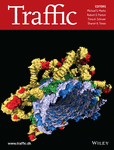Neuronal RNP granules: dynamic sensors of localized signals
Traffic. 2019 Jun 17. doi: 10.1111/tra.12672. [Epub ahead of print]
Formicola N1, Vijayakumar J1, Besse F1.
Author information
1. Université Côte d’Azur, CNRS, Inserm, iBV, Nice, France.
Abstract
Membrane-less organelles, because of their capacity to dynamically, selectively, and reversibly concentrate molecules are very well adapted for local information processing and rapid response to environmental fluctuations. These features are particularly important in the context of neuronal cells, where synapse-specific activation or localized extracellular cues induce signaling events restricted to specialized axonal or dendritic sub-compartments. Neuronal ribonucleoprotein (RNP) particles, or granules, are non-membrane bound macromolecular condensates that concentrate specific sets of mRNAs and regulatory proteins, promoting their long-distance transport to axons or dendrites. Neuronal RNP granules also have a dual function in regulating the translation of associated mRNAs: while preventing mRNA translation at rest, they fuel local protein synthesis upon activation. As revealed by recent work, rapid and reversible switches between these two functional modes are triggered by modifications of the networks of interactions underlying RNP granule assembly. Such flexible properties also come with a cost, as neuronal RNP granules are prone to transition into pathological aggregates in response to mutations, aging, or cellular stresses, further emphasizing the need to better understand the mechanistic principles governing their dynamic assembly and regulation in living systems. This article is protected by copyright. All rights reserved.
PMID: 31206920
DOI:10.1111/tra.12672

